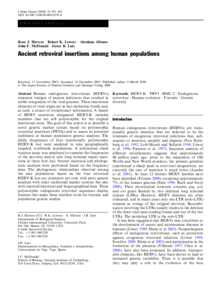Document
Ancient retroviral insertions among human populations.
Identifier
DOI: 10.1007/s10038-006-0370-0
Source
Journal of Human Genetics. V. 51, 4, P. 353-362
Contributors
Lowery, Robert K. , Author
Alfonso, Abraham. , Author
McDonald, John F. , Author
Luis, Javier R. , Author
Country
Japan
City
Tokyo
Publisher
The Japan Society of Human Genetics and Springer-Verlag.
Gregorian
2006-04-01
Language
English
English abstract
Human endogenous retroviruses (HERVs) represent vestiges of ancient infections that resulted in stable integration of the viral genome. These insertional elements of viral origin are in fact molecular fossils and, as such, a source of evolutionary information. A family of HERV insertions designated HERV-K includes members that are still polymorphic for the original insertional event. The goal of this report is to describe a novel genetic marker system based on polymorphic retroviral insertions (PRVIs) and to assess its potential usefulness in human population genetic analyses. The allelic frequencies of four insertionally polymorphic HERV-K loci were analyzed in nine geographically targeted, worldwide populations. A polymerase chain reaction assay was employed to examine the frequencies of the provirus and/or solo long terminal repeat insertions at these four loci. Several statistical and phylogenetic analyses were performed based on the frequency data. The phylogenetic relationships observed among the nine populations based on the four retroviral HERV-K loci are consistent not only with prior genetic analyses with other traditional marker systems but also with reported historical and biogeographical data. These polymorphic endogenous retroviral sequences display features that make them excellent tools for forensic and population genetic studies.
Description
Journal of Human Genetics
Volume 51, Issue 4, April 2006, Pages 353-362
Volume 51, Issue 4, April 2006, Pages 353-362
ISSN
1434-5161
Resource URL
Category
Journal articles

